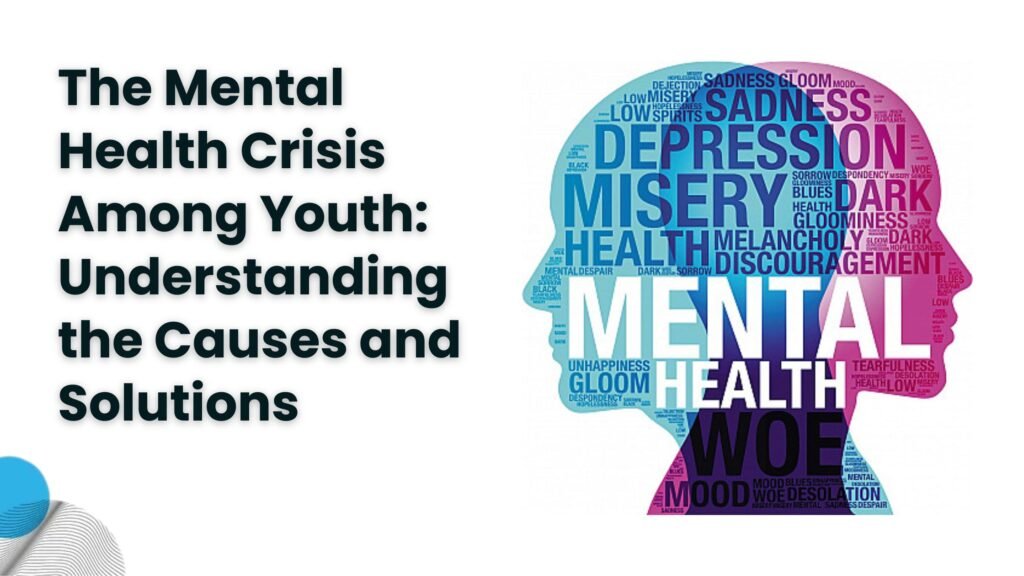Introduction
About one in five children and adolescents around the world is estimated to have a mental disorder, according to data from the World Health Organization (WHO). Ongoing depression among teenagers and females in youthful grownups is a common event today. We should remember that these bearable stats are flesh and blood numbers with hearts, most of them children. But what are the root causes of this alarming trend among youth? But what is considerably more important, is how to end this crisis and take care of the well-being of these youngsters.
Mental illness is a rising tide among our youth.
The issue of mental health disorders on the rise among young people is a complex one, driven by numerous factors. It is important to understand what these causes are in order to develop effective interventions.
1. The Impact of Social Media
One of the biggest drivers for this mental health epidemic is that it has translated across to young people, and a huge part of how we live now our lives comes from us on various platforms giving each other different versions (a more active version) of ourselves. Instagram, TikTok, and Snapchat are critical places in the daily routine of many teens.
With those lifetime achievements and happy moments of social media celebrities, young minds are taking part in a never-ending race.. Although these platforms offer a way to connect and express ourselves, there is no doubt they represent digital minefields.
Social media plaster unrealistic ideals and serve as a breeding ground for comparison, turning into constant competition. Young people are hungry for images and messages that reflect beautiful, successful, or happy ideals. Such non-stop exposure may lead to sexual dissatisfaction, low self-worth, and depression
2. Academic Pressure and Expectations
Academic stress is one of the major contributors that lead to mental health problems among youth. There is so much pressure to do well in school, get good grades, go to a good college and get a great career. Commonly, this ongoing stress eventually leads to anxiety disorders.
A lot of students are bound to expectations from parents, teachers, and their selves. Such high stakes threaten to ignite intense emotional, mental, and spiritual suffering due to the fear of falling short. Making matters even worse is the fact that this pursuit of academic success tends to lead students voluntarily or involuntarily away from other incredibly important facets of overall wellness such as social connections, passion in life, and self-care.
3. Family Dynamics and Relationships
The family environment is also a critical factor in a young person’s mental health. Family dynamics, including divorce, abuse, or ongoing conflict, can have deep and lasting scars on a child’s emotional well-being. When supportive relationships with parents or guardians are lacking, it can result in feelings of loneliness, and insecurity.
Moreover, the decline of traditional joint family structures and the rise of single-parent households and nuclear families can add to the emotional difficulties many young people face. The lack of a stable, supporting, and nurturing family environment can lead to a range of mental health challenges, including anxiety, depression, and behavioral issues.
4. Economic and Societal Pressures
Economic instability and societal pressures also play significant roles in the mental health crisis among youth. In many communities, young people face uncertain futures due to economic hardships, job insecurity, and the rising cost of living. The fear of not being able to achieve financial independence or live a comfortable life can create immense stress and anxiety.
Additionally, society keeps on making unrealistic expectations regarding gender roles, body image, and sexual orientation can contribute to mental health struggles. Those who feel marginalized or who do not conform to societal norms may experience feelings of isolation, discrimination, Fear of Missing Out(FOMO), and low self-worth, all of which can negatively impact their mental health.
Addressing the Crisis: Solutions and Interventions
We have talked about the causes of mental illness, and here are some steps that can be taken to address its impact. These solutions involve a multi-faceted approach that includes individuals, families, schools, and communities working together to support the mental well-being of youth.
1. Promoting Mental Health Education and Awareness
One of the main methods to battle this mental health crisis is further awareness and education to understand better these issues. By incorporating mental health education into their curricula, schools have an important role to play Educating young people about the significance of mental health, signs of mental illness, and how to seek help can put students in control over their well-being.
Here too, normalizing open dialogue about mental health matters should extend beyond campus to families and communities to combat the stereotyping of those who suffer its woes. These messages can lighten up a dark space and empower someone to open up about their battles because while having the ear of a family is important, these are often things that one would not like to fess up to for fear of judgment or evaluation.
Access to mental health resources and services is critical for addressing the mental health needs of young people. In many societies, counseling a psychologist is considered a thing to be ashamed of. These mindsets of people need to change and seeking professional help should be encouraged.
2. Reducing Academic and Social Pressures
To alleviate the academic and social pressures that contribute to mental health issues, schools, and families must work together to create a more balanced and supportive environment for young people. This can include re-evaluating academic expectations, encouraging a healthy balance between schoolwork and extracurricular activities, and allowing them to learn at their own pace and stress management techniques.
Parents and educators can also play a role in reducing social pressures by fostering an environment where young people feel valued for who they are, rather than for their achievements, status, or bank balance. Encouraging positive social interactions and building a sense of community can help young people feel more connected and supported.
3. Strengthening Family and Community Support Systems
The social science evidence on this is overwhelming: young people need strong family and community support to be mentally well. Parents can encourage open dialogue, offer emotional support, and create a safe environment in which children may thrive. Local community programs, parenting courses, family counseling, and youth mentoring opportunities can be offered by communities to provide families with tools.
By working together, families and communities can create a network of support that helps young people navigate the challenges they face and promotes their overall mental health and well-being.
Conclusion
The youth mental health crisis is a complex issue and needs to be approached holistically. By understanding the roots of this crisis and enacting interventions that work, we might yet build a society in which all our youth find their psychological footing. We need more programs and services to address this issue, including school mental health education, youth-friendly service delivery for early intervention, and reducing pressures on young people as well as strengthening the family support system.
Together, we can make a difference in the lives of millions of young people and help them build a brighter, healthier future.





Leave a Reply